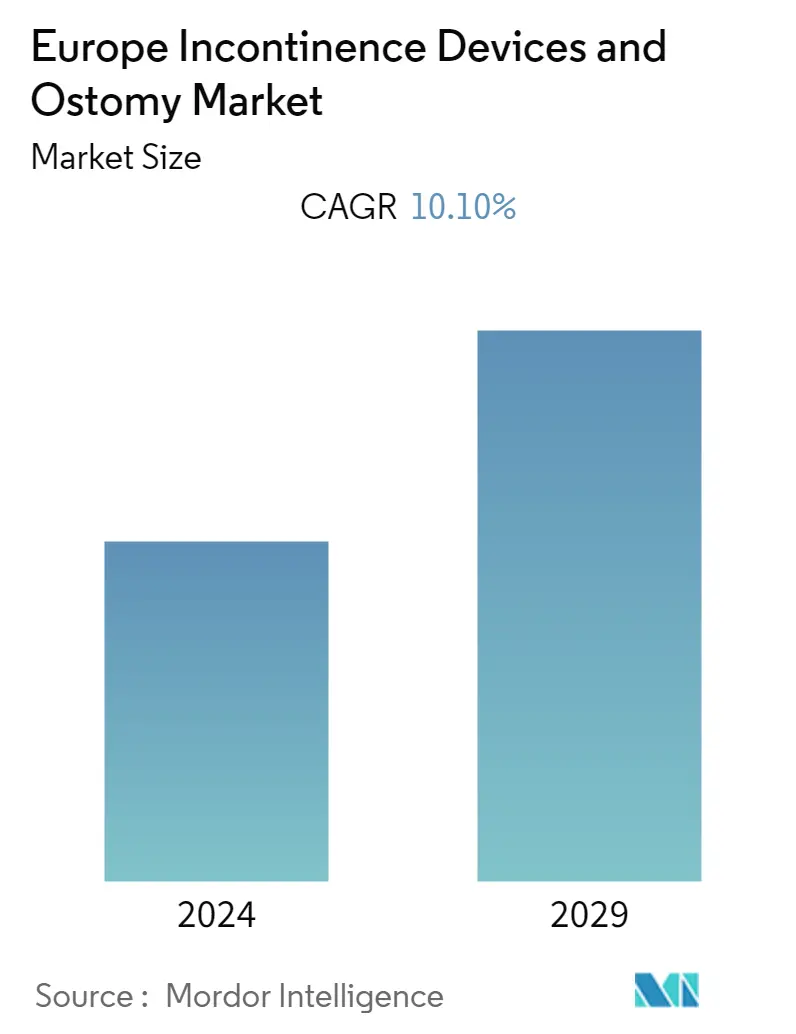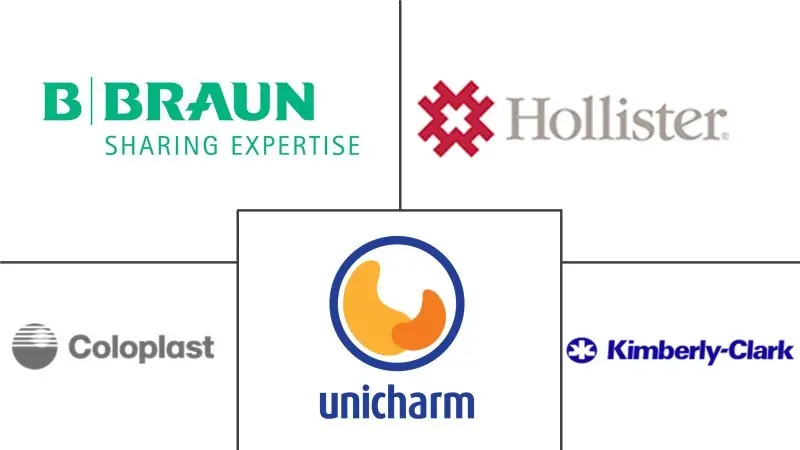Market Size of Europe Incontinence Devices and Ostomy Industry

| Study Period | 2019 - 2029 |
| Base Year For Estimation | 2023 |
| Forecast Data Period | 2024 - 2029 |
| Historical Data Period | 2019 - 2022 |
| CAGR | 10.10 % |
Major Players
*Disclaimer: Major Players sorted in no particular order |
Europe Incontinence Devices & Ostomy Market Analysis
The European incontinence devices and ostomy market are expected to register a CAGR of 10.1% during the forecast period.
COVID-19 had a significant impact on the growth of the market. This was due to the halt of visits to healthcare centers such as clinics and hospitals and the unavailability of proper treatment procedures. For instance, the research study published in Springer in March 2022 mentioned that, overall, a 19.5% reduction in ostomy closure occurred between March 2020 and February 2021. In such circumstances, patient care was delivered through telemedicine services in Europe. Additionally, in a research article published in Springer in August 2020 in Southern Italy, a telemedicine-based pathway was developed for emergency care outpatients with a colostomy as a response to the postponements of patient visits. Such delays in outpatient visits led to a short-term decline in the demand for incontinence and ostomy devices. However, the relaxation of the strict regulations in Europe led to the reopening of healthcare centers and an increase in patient inflow, thereby driving the demand for incontinence devices and ostomies and boosting the growth of the market over the forecast period.
Factors driving market growth include the rising geriatric and obese populations, the increasing prevalence of renal diseases and nephrological injuries, and the growing awareness and acceptance of ostomy care products.
According to a United Nations report published in 2022, by 2050, one in every four people in Europe will be 65 or older. Similarly, Italy has approximately 23.6% of its population aged 65 and older, according to the United Nations Population Fund's World Population Dashboard Statistics 2021. As the geriatric population becomes more vulnerable to kidney disorders, the demand for incontinence devices and ostomies is expected to rise, which is expected to contribute to the growth of the market studied. Additionally, the prevalence of renal disorders among the European population is expected to contribute to the growth of the market. As per the Lancet article published in June 2022, one in ten adults in Europe is likely to have chronic kidney disease. Similarly, as per the European Kidney Alliance report published in 2021, a staggering 75 million people suffer from chronic kidney disease in Europe. Such prevalence of chronic kidney disorders among the European population is expected to contribute to rising demand for Incontinence and ostomy devices in Europe, which is poised to drive market growth over the forecast period.
Thus, the aforementioned factors are expected to drive the growth of the market over the forecast period. However, the lack of proper reimbursement and complications associated with ostomy devices, and the usage of incontinence products are expected to restrain the growth of the market.
Europe Incontinence Devices & Ostomy Industry Segmentation
As per the scope of the report, ostomy surgery is a procedure that allows bodily waste to pass through a surgically created stoma on the abdomen. Ostomy care products, such as skin barriers and ostomy bags, provide means for the collection of waste from a surgically diverted biological system. In incontinence, there is a lack of voluntary release of contents from the urinary bladder, for which several disposable incontinence products (DIP) are manufactured by the leading medical device companies. The Europe Incontinence Devices and Ostomy Market is Segmented by Product Type (Incontinence Care Products (Absorbents, Incontinence Bags, and Other Product Types) and Ostomy Care Products (Ostomy Bags (Colostomy Bags, Ileostomy Bags and Urostomy Bags), Skin Barriers, Irrigation Products, and Other Ostomy Products)), by Application (Bladder Cancer, Colorectal Cancer, Crohn's Disease, Kidney Stone, Chronic Kidney Failure, and Other Applications), and by Geography (Germany, United Kingdom, France, Italy, Spain, Rest of Europe). The report offers the value (in USD million) for the above segments.
| By Product Type | ||||||||||
| ||||||||||
|
| By Application | |
| Bladder Cancer | |
| Colorectal Cancer | |
| Crohn's Disease | |
| Kidney Stone | |
| Chronic Kidney Failure | |
| Other Applications |
| Geography | |
| Germany | |
| United Kingdom | |
| France | |
| Spain | |
| Italy | |
| Rest of Europe |
Europe Incontinence Devices and Ostomy Market Size Summary
The European incontinence and ostomy devices market is poised for significant growth, driven by an increasing geriatric and obese population, alongside a rising prevalence of renal diseases and nephrological injuries. The market experienced a temporary setback due to the COVID-19 pandemic, which disrupted healthcare services and led to a decline in demand for these devices. However, the subsequent relaxation of regulations and the reopening of healthcare facilities have spurred demand, with telemedicine playing a crucial role during the pandemic. The growing awareness and acceptance of ostomy care products further contribute to the market's expansion. Despite challenges such as inadequate reimbursement and complications associated with ostomy devices, the market is expected to grow steadily over the forecast period.
Colorectal cancer is anticipated to be a dominant factor in the market's growth, with its rising prevalence driving the demand for incontinence devices. The United Kingdom is expected to lead the market, supported by its increasing geriatric population and high incidence of renal diseases. Major players in the market, including Abena AS, B. Braun Melsungen AG, and Coloplast Corporation, are actively involved in shaping the competitive landscape. Innovations such as Ontex's digital incontinence management service highlight the industry's focus on technological advancements. The market's growth trajectory is further supported by strategic investments and developments aimed at addressing fecal and urinary incontinence conditions.
Europe Incontinence Devices and Ostomy Market Size - Table of Contents
-
1. MARKET DYNAMICS
-
1.1 Market Overview
-
1.2 Market Drivers
-
1.2.1 Rising Geriatric and Obese Populations
-
1.2.2 Increasing Prevalence of Renal Diseases and Nephrological Injuries
-
-
1.3 Market Restraints
-
1.3.1 Lack of Proper Reimbursement
-
1.3.2 Complications Associated with Ostomy and Usage of Incontinence Products
-
-
1.4 Porter's Five Force Analysis
-
1.4.1 Threat of New Entrants
-
1.4.2 Bargaining Power of Buyers/Consumers
-
1.4.3 Bargaining Power of Suppliers
-
1.4.4 Threat of Substitute Products
-
1.4.5 Intensity of Competitive Rivalry
-
-
-
2. MARKET SEGMENTATION (Market Size by Value - USD million)
-
2.1 By Product Type
-
2.1.1 Incontinence Care Products
-
2.1.1.1 Absorbents
-
2.1.1.2 Incontinence Bags
-
2.1.1.3 Other Product Types
-
-
2.1.2 Ostomy Care Products
-
2.1.2.1 Ostomy Bags
-
2.1.2.1.1 Colostomy Bags
-
2.1.2.1.2 Ileostomy Bags
-
2.1.2.1.3 Urostomy Bags
-
-
2.1.2.2 Skin Barriers
-
2.1.2.3 Irrigation Products
-
2.1.2.4 Other Ostomy Products
-
-
-
2.2 By Application
-
2.2.1 Bladder Cancer
-
2.2.2 Colorectal Cancer
-
2.2.3 Crohn's Disease
-
2.2.4 Kidney Stone
-
2.2.5 Chronic Kidney Failure
-
2.2.6 Other Applications
-
-
2.3 Geography
-
2.3.1 Germany
-
2.3.2 United Kingdom
-
2.3.3 France
-
2.3.4 Spain
-
2.3.5 Italy
-
2.3.6 Rest of Europe
-
-
Europe Incontinence Devices and Ostomy Market Size FAQs
What is the current Europe Incontinence Devices and Ostomy Market size?
The Europe Incontinence Devices and Ostomy Market is projected to register a CAGR of 10.10% during the forecast period (2024-2029)
Who are the key players in Europe Incontinence Devices and Ostomy Market?
Kimberly-Clark Corporation, Unicharm Corporation, Coloplast Corporation, Hollister Inc. and B. Braun Melsungen AG are the major companies operating in the Europe Incontinence Devices and Ostomy Market.

